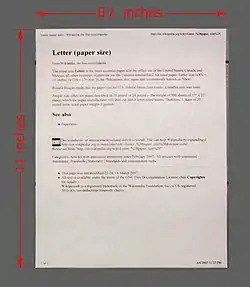Letter (paper size)
Letter or ANSI Letter is a paper size standard defined by the American National Standards Institute, commonly used as home or office stationery in the United States, Canada, Chile, Colombia, Costa Rica, Mexico, Panama, Guatemala, the Dominican Republic and the Philippines. It measures 8.5 by 11 inches (215.9 by 279.4 mm) and is similar in use to the A4 paper standard at 210 mm × 297 mm (8.27 in × 11.7 in) used by most other countries, defined in ISO 216 by the International Organization for Standardization.



Details
The Reagan administration made Letter-size paper the norm for US federal forms in the early 1980s; previously, the smaller "official" Government Letter size, 8 by 10.5 inches (203.2 by 266.7 mm) (aspect ratio: 1.3125), was used in government, while 8.5-by-11-inch (215.9 by 279.4 mm) paper was standard in most other offices.[1] The aspect ratio is 22/17 ≈ 1.294 and the diagonal is √8.52 + 112 ≈ 13.901 inches (353.1 mm) in length.
In the US, paper density is usually measured in "pound per reams" (of 500 sheets). Typical Letter paper has a basis weight of paper of 20 or 24 pounds (9.1 or 10.9 kg) – the weight of 500 sheets (a ream) of 17-by-22-inch (431.8 by 558.8 mm) paper at 70 °F (21 °C) and at 50% humidity.[2] One ream of 20-pound Letter-sized paper weighs 5 pounds (2.3 kg), and a single Letter-sized sheet of 20-pound paper weighs 0.16 ounces (4.536 g), which is equivalent to 75.19 g/m2. Some metric information is typically included on American ream packaging. For example, 20-pound paper is also labeled as 75 g/m2. The most common density of A4 paper is 80 g/m2.
The related paper size known as half letter, statement, or organizer L is exactly one half of the US Letter size: 8.5 by 5.5 inches (215.9 by 139.7 mm) (8.5 × 5.5 in).
History
The precise origins of the dimensions of US letter-size paper (8.5 × 11 in) are not known. The American Forest & Paper Association says that the standard US dimensions have their origin in the days of manual papermaking, the 11-inch length of the standard paper being about a quarter of "the average maximum stretch of an experienced vatman's arms".[1] The letter size falls within the range of the historical quarto size, which since pre-modern times refers to page sizes of 8 to 9 inches (200 to 230 mm) wide and 10 to 11 inches (250 to 280 mm) high, and it is indeed almost exactly one quarter of the old Imperial (British) paper size known as demy quarto – 17+1⁄2 by 22+1⁄2 inches (440 by 570 mm) – allowing a 1⁄2 inch (13 mm) for trimming.[3]
Tiling
8-1/2 x 11 paper can be almost perfectly tiled with equilateral triangles when the paper is divided into thirds. See image at right. The error in the lengths of the sides of the triangles is only 0.3%. The pattern of triangles and therefore a close approximation of the 8-1/2 x 11 ratio can be generated with nothing more than a compass and a straight edge.
See also
References
- American Forest and Paper Association. "Why is the standard paper size in the U.S. 8 ½" x 11"?". Archived from the original on February 20, 2012. Retrieved 2014-02-20.
- Blocksma, Mary. Reading the Numbers. New York: Penguin Books, 1989.
- Fyffe, Charles (1969). Basic Copyfitting. London: Studio Vista. p. 74. ISBN 0-289-79705-5.